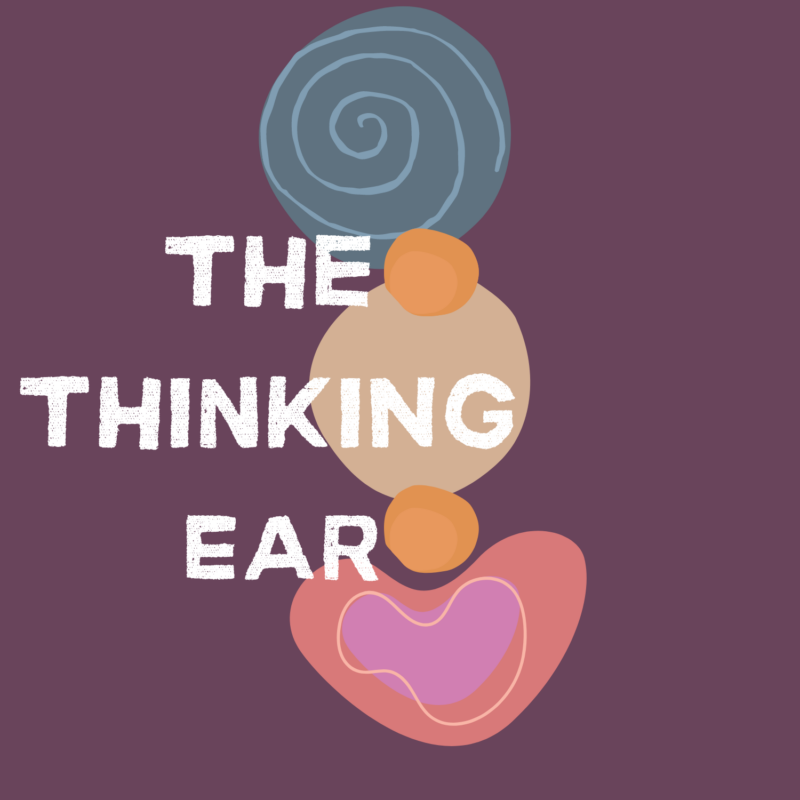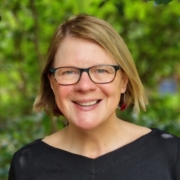Jordan Corson
Schools Infinitum or the Jorge Luis Borges School of Inclusion
 Today we launch a new project at FreshEd called The Thinking Ear. The Thinking Ear is a collection of episodes produced by you, offering a sonic space to share ideas on education worldwide. Think of it as an audio journal.
Today we launch a new project at FreshEd called The Thinking Ear. The Thinking Ear is a collection of episodes produced by you, offering a sonic space to share ideas on education worldwide. Think of it as an audio journal.
If you’re interested in developing your own podcast episode about your research, please get in touch. The Thinking Ear is open for submissions. We will offer support to develop your idea into a podcast before airing it on the FreshEd platform. We think a space for anyone to contribute a podcast episode is important because sonic productions expand our understanding. Research is no longer confined to niche journal articles or shared in half-empty conference rooms. Podcasts encourage us to think both analytically and creatively about research and increase our public impact. We want to democratize podcast creation by offering our listeners opportunities to make their voices heard. So welcome to The Thinking Ear and I hope many of you will consider making your own episodes in the future.
To kick things off Jordan Corson tells a short story about a particular understanding of the idea of universal education, composed in the style of writer Jorge Luis Borges. Jordan Corson is an Assistant Professor of education at Stockton University.
We believe that the author came from the south. He was the first stranger we had welcomed for some time. The way he spoke. His appearance. Nothing externally distinguished him, but still we knew he came from elsewhere. Living amongst us, he joined us during the day and shared our meals. It was said, though we do not recall him telling it directly, that he had visited every known place and some unknown places as well.
He spoke little, though asked occasional questions about our work. Since he was blind, he asked that we read to him each night. He preferred dusty texts into which we could lose ourselves. Tales of other places that wound through labyrinths of stories. Nightly, we learned, gathering around the fire within the crumbling stone walls at the edge of the fields. From mysterious tomes he carried with him, he taught us histories of various places. Once, as we read, we came across an odd word. School.
I asked if he recognized the word’s meaning. He explained that yes, he knew its significance and history.
If we promised to ask nothing, change nothing, and to do nothing once he described it, he would tell us about this word. We agreed, put down the book we were reading, and prepared to listen to the author. This is the story he told:
“In my travels, I came upon a strange land. Tired and curious, I took an apartment in a busy area. Once I had organized my clothes and placed my books in a pleasing order on the room’s shelves, I began to notice the pristine makings of the apartment, the almost-sterile appearance of the cabinets and dressers. During my walks, I noticed that the same could be said about this place in general. Unlike the wide pathways or elaborate lampposts decorating my ancestral land, this place appeared with rigid certainty. Intrigued, I prepared to spend some time there, wandering and exploring. As you will see, however, such aimlessness became impossible.
“This land forced a kind of efficiency. For instance, though I had arrived during a colder and darker time of year, the people there did not follow the pace of the sun. Instead, at the exact same times each day, a noise rang out, audible to everyone. Shortly thereafter, people emerged, striding from one place to another. Also, as I walked, I noticed that the streets carried a specificity unfamiliar to me. As if living on a geometric plane, one could not lose oneself while walking. In the afternoons, I tried meandering this way or that, choosing by impulse where to go. I discovered new places. But, each time I looked up, seeing the signs of this place, I still knew where I was. Uncertainty seemed impossible. Undetermined space appeared absent from this land. After some time, I inevitably gave up and returned to my apartment, knowing by the numbers of the streets and buildings how to return. Despite this consistency, the land also appeared permanently in flux. One morning, on my walk, I noticed a series of tall structures. I could not be sure but only the day before they had not been there. Now these buildings stood, somehow contrasting and predicting the land’s form.
In our land, we wandered across the fields, moved through the woods nearby. We ate, often together. Conversations and work moved us. Our lives never dull. The weather or visits from strangers like the author altered our rhythms. Such a world, though, was not yet recognizable. The author said,
“I would soon learn that this place had become a land of lines. Many people there had in fact become quite fond of them. I came to understand that the lines were directions, paths to follow. And, they were borders, teaching where things belonged. They enclosed and protected. As lines took hold of the land, they unfolded, expanding to form grids. These lines told people where something was and where it was not, who had something and who did not, and what should count as what. They divided people, places, and eventually even ideas. Lines gave the land shape and significance. They thrust skyward, plunged into the earth, and pulled across it. You see, what had once been undetermined was now visible, counted, named, known.”
The evening grew darker as we contemplated such a land. To hold the world in place, to mold it, made little sense. And yet, what if we did not become lost within the woods as sometimes happened? If some scientific rendering might teach us the way back. How would our lives change if our days moved not by desire or nature but by some outside force? The author continued,
“Only some people drew the lines. Full of hubris, the line drawers mapped and measured, ordered and numbered, partitioned and filed. Most people lived in the consequences of this work. I too found myself within their rhythms. As I settled into this place, some lines suddenly just seemed to be. No matter their origin or purpose, they seemed to make things easier. They pushed toward a life not possible without their direction. Over time, the lines became clearer and stronger, less movable.
“The lines themselves were often mysteries. Some I could see for myself. Others did not seem to exist at all. Yet their impact was evident. People appeared to understand that a line had formed in a particular place and for a specific purpose. Even in moments when people stood mixed together, everyone knew who belonged on which line or, when a line divided, who stood to which side.”
The author paused and shifted position. He seemed to be looking at us, deliberating.
“Then, all too suddenly, a different line was coming to be. I was there myself when tracings of the line seemed to spontaneously scatter across the land. This line would be one of training, of formation, and one of knowledge and thought. Such a place could, they believed, reinforce or even remake the land as the line drawers saw it. A guild of line drawers took charge and named themselves ‘learning scientists.’ They named their line school.
“From the beginning there were many disagreements and zealous conversations. What should the line look like? Which people in the land should cross it? If it were a place to cultivate knowledge, what kinds were to be included? What comportments, ideas, and even bodies might be desirable for such a place? Some believed school would be a place of efficiency, making lines throughout the land more useful. Others saw it as a way to improve the lines themselves.
“New voices of learning scientists arose, believing school could be a place for everyone in the land. Their idea was born of utility. In service of the lines, this new place could touch everything. School would perfect the land and its subjects. A chant of universality, of all within the land belonging to the line, took hold.
“So the schools came to be. Vast edifices composed of quadrangular structures. Inside each, I heard one could walk along long corridors and see clear arrangements of interior quadrangles. Clear hierarchies of people filled the structures to guide those on the inside. Regimented schedules reflecting the ways of the land of lines. A uniformed process was established for the way school was. Anyone could walk nearby and see, instantly, that they had come upon it. The look, feeling, everything about it revealed a specifics of place.
But universality proved elusive. Some people were pulled by other lines. Or they saw the land in different ways. They had their own ideas about this new line that challenged the learning scientists. Thus, many were not included. Against the dream of all belonging, it presented a great problem to solve.”
We wanted to offer the kindness of listening to the author, but we, who had not been marked in such ways, did not understand the problem. What purpose did this and other lines serve?
“In the land of lines such questions often faded behind the desire to belong. One morning, as I walked, I noticed a commotion. A new line was emerging. A school like so many others in this place. Here, urgency encompassed the forming line. People clambered, pushing and climbing. The crowd grew, frantically pulsed.
“I was caught within the swell of people and sensed a desire, a need, moving through the crowd, as if crossing this line were a necessary movement. The lines outside the school funneled people so that at any given time only a few specially positioned could pass into the forming line. Desperation whistled through the crowd until the line snapped into place. No more could cross. Those on the outside were to remain on the outside and would need to wait or look elsewhere. Slowly, pressure released and the order of the land returned. As people meandered from the line, I caught the attention of someone who had been pressed beside me in the crowd. ‘What happened,’ I asked. They explained only that a new school had formed and then walked on.
“There were other times as well. People who made their lives a shrine to the lines. Those who fought line makers. People who wanted to smash the lines entirely. To build schools against lines…But that is a story for another night. In any case, time moved along. New lines formed. More people crossed the line of school, but still not all. When so many new lines did not solve the problem, the learning scientists paused to note who remained on the outside.
“On their march toward the universal, they realized that when they said everyone, as they dreamed of everyone crossing the line, they did not know who everyone was in this land. At this point, everyone indexed not everyone but only some everyones, those fully named and categorized as everyone. Others could not yet belong. They wandered lines on the outside of school. They were incapable, not ready, their inclusion a risk to the lines themselves. The learning scientists, themselves built by a world of lines, saw that the lines would need to morph for them to become universal. They explored what could be done.
“They learned the ridges, interrogated the margins, and peered into the hidden crevices of infinity. A fundamental truth of the land of lines revealed itself. The lines, once formed, made different kinds of everyone. Lines would need to both expand and adapt. And so, they made lines within lines. Zigzags, rays, great sloping parabolas that could overlap, collide, and jigsaw together. Within the grand line signifying the dream of infinity, they made interior bifurcations and borders, divisions that would include more people, in a certain fashion. Even as the lines spilled from themselves, becoming frayed rhizomes, they grew stronger, brighter.”
At this point, our interest began to fade. We wandered from the author, thinking we might walk along the shore. He had not called to us and no longer spoke. There seemed to be an understanding that the story would not continue. Perhaps, like we had done so many evenings, we would build something in the darkness. There was still much time left in the night. We moved off some distance, stomping across the tall grass. As we looked back, we noticed his silhouette, patient, almost expectant. The flames that warmed him shimmered across his face. A stillness crept into the evening. Without thinking, we returned to the place where the author sat and settled around him. He continued, as if no interruption had occurred.
“One day, as the story I heard goes, some learning scientists met in one of their laboratories. These scientists had been working on questions of exceptions, something completely unacceptable in the land of lines. Lines, after all, were solutions for all possible incongruities. Solutions required naming and knowing, making visible all who might be or become exceptions, and having them cross the line of school as a solution.
“Conversations like this filled their experiments. Other observations confirmed that, as theorized, the line of school could change the people of the land, moving and conforming minds to fit the line. People could only go inside the line if they made the necessary adjustments. Often, the line demanded it. In some moments, the lines moved outward, including people who had no intention of crossing, foisting a naming and a cleaving. Living on the outside, people still conformed, behaving according to the orders of the line. New fights stirred, asking why the lines should change at all, for whom they would change, and what any change would mean for this not-yet universal line called school.
“Those still on the outside were studied. The lines were re/formed over and over. They repurposed other lines. School was not just something stable to cross, but a line whose thickness and dimension could expand to unknown size. They did not know if such findings would help them achieve their goal.
“They drew lines in many places, across many ideas. With each new composition, they found success in making school. A particular quadrant of the land’s forest. Upon one of their boats. These places became schools! Then, they tested the lines for ideas. From the smallest arithmetical measure to the grandest philosophical explorations, school could be for anything and could occur anywhere. Others in the guild wondered if such expansion might weaken the line of school.
“They did not answer these questions, deciding only to continue. No longer about knowledge, behavior, or the good of the land, school became an established fact, an unquestioned line. The reason of school was the reason of school.
“After some time, the learning scientists calculated that with the number of lines they had drawn, it would be mathematically impossible to leave out any person in the land. And yet, once more, people did not cross the line. They were obscured, left outside. Still, they refused. Or they did not fit into the perfect efficiency of a land made of lines. New concerns arose as new people arrived and new lines emerged. Old debates about the lines returned.
“Eventually, I left the land of lines in search of new places. Walking away, I reached a hill just outside its borders. I peered back. From that distance, the land appeared as a labyrinth. What had once seemed a pristine grid now looked like a series of tangled knots. I was not a line drawer, but I could only imagine partial, inelegant solutions to their problems.
“Only some time later, as I made my way to you in fact, did I learn what became of the learning scientist’s project. A fellow traveler told me that the learning scientists had burrowed into their laboratories. Meanwhile, the gears of school continued. Lines constructed by other line drawing guilds aided the cause, making school a critical feature of the land of lines. But for a long time, no one heard from the learning scientists. The dream of universality faded to reverie.
“One day, quite suddenly, the learning scientists emerged. This was the solution they discovered: Every person, though belonging to many groups, avoiding or slipping from the line of school, or included into various parts of the land of lines in various ways, is unique. The possibilities for them to cross the line, to travel another line, or to stay within the line of school fill endless permutations.
“To reach one infinity, the learning scientists had neglected another, already-present infinity.
They had therefore drawn the line incorrectly. If school were to reach toward a totality of inclusion, they could neither cast outward and draw lines upon lines nor could they continue the cyclical cleaving of naming and including. It must, they concluded, be drawn for each individual. The learning scientists shared their schematics.
“School would become a line, drawn around each individual person in the land, encompassing them. It would not be a series of lines to be built ever outward, moving toward a point on the horizon, a boundary to cross and into which everyone should be included. Instead, the line should be built inside each person from the start of their lives. If the line were properly constructed, every movement would be an act of being included into school. Eating meals. Walking in the town square. Going to the bathroom. These moments became part of being included in school.
“School would become an Aleph, wherein all would exist. Outside the line would be inside the line as well. The line would need to learn, to adapt, to individuate, but it must only be one line for each person. To welcome another in the same place meant a chance that the second person would not be included in the line. As each person decided something, as they learned, the school would reinscribe that person into their own singular line. The number of schools equaled the number of people in the land. A self-contained infinity. To ensure success, the lines became places to rid the future and past and to limit interaction among people, for each moment came to produce a difference that created variations, ones open to rebellion against their perfect structure. School must contain, encase everyone, holding them in lest they escape into exclusion. No people would ever again be able to enter or exit the land of lines. People became lines themselves and the dream of universal education was realized.
“In the following generations, people in the land grew weary of such dreams. They abandoned the learning scientists, their ideas of infinity, and traveled elsewhere.”
We had promised the author that we would ask nothing once the story concluded, but I wanted to know more.
Want to help translate this show? Please contact info@freshedpodcast.com
Have any useful resources related to this show? Please send them to info@freshedpodcast.com









